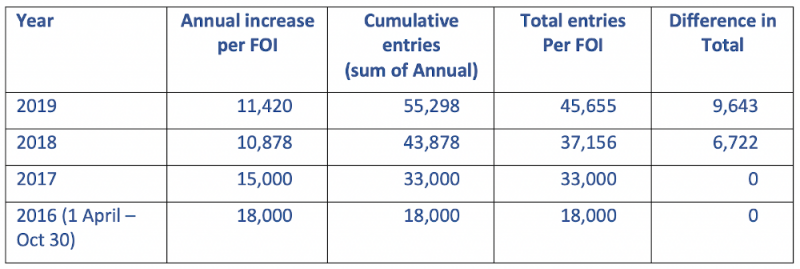The National Custom and Self Build Association (NaCSBA) has released its final analysis of the practice around local authorities and their activity. The data follows its initial announcement of the early data, released in January, that revealed that councils were restricting people from signing the Right to Build registers with a series of “dirty tricks”.
The final analysis reflects the most complete set of data NaCSBA has had access to to date, which represents a 97% response, based on responses from 317 of the 327 planning authorities in England. The overall number of authorities has decreased by 9 than 2018, due to merged authorities.
Key findings
Extrapolating this data to reflect the situation across England, NaCSBA estimates that the number of new individual entries on registers to be 11,420.
This is 5% more than the 10,878, with individual entries up by 8%, while group entries are down. This is the first year-on-year increase we have seen since the registers were launched and a welcome increase against 2018. This is especially so in light of the increasing barriers to joining registers, which are suppressing demand.
NaCSBA also estimates that the overall numbers on the registers is now at 45,655. This is up by 8,499 from the 37,156 last year but is considerably less than the 11,420 new additions.
This will be largely due to the removal of existing entries from registers – a practice that NaCSBA does not accept. The cumulative impact of these changes has been to remove over 9,000 entries from registers. Without such actions it estimates the totals on registers would be over 55,000 by now.

In addition the data demonstrated that:
- 31% of councils now impose some restriction on joining registers, up from 26% last year.
- The proportion of local connection tests (30%) and charges (15%) both continue to rise, although in both cases the rate has slowed.
- It was not possible to establish actual delivery as required by the legislation, due to the mixed picture of activity. To date only 58% of Councils have indicated they have complied, 23% appear not to have complied and 19% have either not responded to our request or have not answered the question.
- For the first time NaCSBA tracked Community Infrastructure Levy exemptions as a source of evidence for provision of self build homes. Again using extrapolation, this found that 6,000 homes were being built across the country could quality for CIL, were it administered by every local authority.
Andrew Baddeley-Chappell, NaCSBA CEO commented, “The wider picture that is emerging of local authority activity with regards the Right to Build suggests that the 30 October 2019 deadline appears to be driving activity by some local authorities to manage registers down rather than manage delivery up.
“However, outside the registers the picture does appear more positive, as self and custom build becomes referenced in more local plans, but there is much still to do”.
NaCSBA is calling on Government to act before bad practice becomes too embedded. This is especially important because the multi-year process means that there is already a large amount of manipulated information within the system already. This needs to be addressed, or allowed to work its way through.
Right to Build Background
Right to Build legislation requires all planning authorities in England (including National Parks) to maintain a register of individuals and groups seeking to acquire land on which to build their home.
Entries onto the register are recorded in annual base periods ending 30 October each year. Local authorities have 3 years after the end of the base period to provide sufficient suitable development permissions.
The first (shortened) base period ran from 1 April 2016 to 30 October 2016 meaning the obligation must have been met by permissions granted between 31 October 2016 and 30 October 2019.

